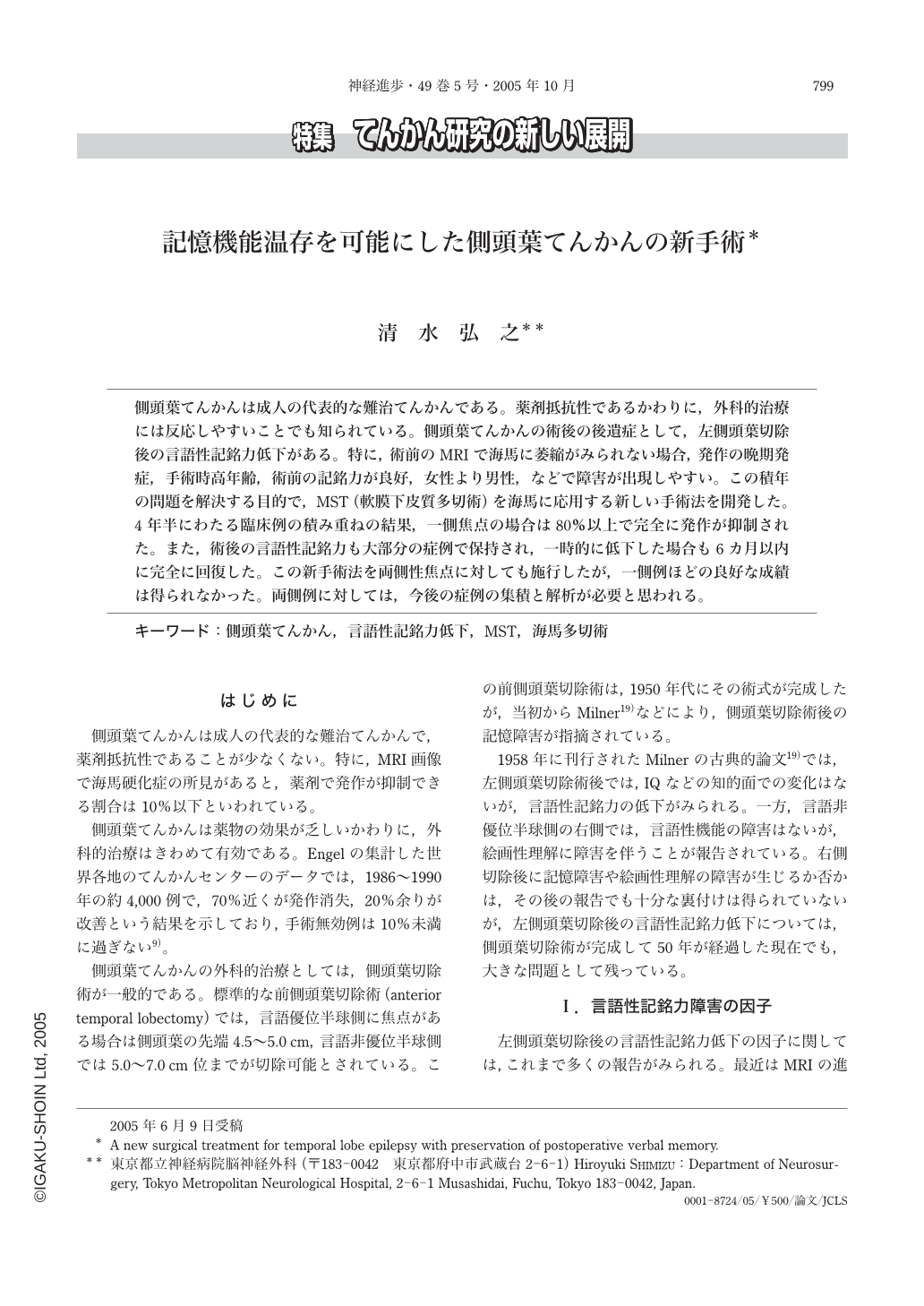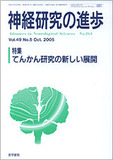Japanese
English
- 有料閲覧
- Abstract 文献概要
- 1ページ目 Look Inside
側頭葉てんかんは成人の代表的な難治てんかんである。薬剤抵抗性であるかわりに,外科的治療には反応しやすいことでも知られている。側頭葉てんかんの術後の後遺症として,左側頭葉切除後の言語性記銘力低下がある。特に,術前のMRIで海馬に萎縮がみられない場合,発作の晩期発症,手術時高年齢,術前の記銘力が良好,女性より男性,などで障害が出現しやすい。この積年の問題を解決する目的で,MST(軟膜下皮質多切術)を海馬に応用する新しい手術法を開発した。4年半にわたる臨床例の積み重ねの結果,一側焦点の場合は80%以上で完全に発作が抑制された。また,術後の言語性記銘力も大部分の症例で保持され,一時的に低下した場合も6カ月以内に完全に回復した。この新手術法を両側性焦点に対しても施行したが,一側例ほどの良好な成績は得られなかった。両側例に対しては,今後の症例の集積と解析が必要と思われる。
Mesial temporal lobe epilepsy is one of the most drug-resistant epilepsies in adults. However, it is also well known that this type of epilepsy shows very positive responses to surgical treatment. According to Engel's report in 1993, almost 70% of patients who underwent temporal lobectomy became seizure-free. Despite good seizure control, postoperative worsening of verbal memory in patients with a left temporal lobe focus has been a long-standing problem. The deterioration of verbal memory is more prominent in patients with late onset seizures, preoperatively high level of verbal memory performance, higher age at surgery, or masculine gender.
To cope with this problem, we applied the surgical technique of MST(multiple subpial transection)to the hippocampus. To gain a safe access to the hippocampus without disrupting the neuronal pathways related to verbal memory, we placed a small corticotomy on the superior temporal gyrus along the sylvian veins within 4.5cm from the temporal tip. Aspirating the medial gray matter of the superior temporal gyrus along the arachnoid membrane of the sylvian fissure, the temporal stem, which is the roof of the temporal horn, is exposed. By suctioning the white matter of the temporal stem, the temporal horn is opened and the hippocampus and the amygdala are fully exposed in the surgical field.
In mesial temporal lobe epilepsy, the pyramidal cell and the granular cell layers of the hippocampus are the most responsible areas for epileptogenesis. To transect the horizontal neuronal connections of these layers, we used specially designed ring-transectors with diameters of 2mm and 4mm. The surface of the hippocampus is covered with an extremely tough membrane called the alveus, in which neuronal fibers run from the hippocampus to the fimbria. Firstly, the alveus is sharply cut with microscissors and ring transectors are inserted through the slit. A 2mm ring transector is used to disconnect the pyramidal layer from CA1 to CA3. At the bilateral corners near the fimbria medially and the collateral eminence laterally, a 4mm ring transector is applied to disrupt the deep granular cell layer and the pyramidal cell layer near the subiculum.
Intraoperative electrocorticography(ECoG)was recorded before and after hippocampal transection. Based on the initial ECoG over the hippocampus, the extent of transection was determined. After completion of transection, active epileptic discharges completely disappeared as long as transection fully covered the epileptic areas.
For the past four and a half years, 27 cases of unilateral temporal lobe epilepsy(left;16, right;11)without hippocampal atrophy on preoperative MRI underwent hippocampal transection. Of 17 cases with>1 year follow-up, 14 cases(82%)remain seizure free, two cases have rare seizures, and one was significantly improved. In left temporal lobe epilepsy, AVLT(auditory verbal learning test)was performed preoperatively and 3-4 weeks and 6 months after surgery. Of 7 cases in which full data are available, 6 cases did not show any deterioration even immediately after surgery. One patient, who showed a transient worsening of AVLT score, completely recovered to the preoperative level 6 months after surgery.
In 11 patients with bilateral epileptic foci verified by intracranial electrodes placement, bilateral hippocampal transection was performed in two stages with more than 6 months between the two procedures. In contrast to unilateral cases, the surgical outcome of bilateral hippocampal transection was extremely discouraging. In 10 cases with>1 year follow-up, only one patient remains seizure-free, three have rare seizures, four were significantly improved, and 2 have shown no significant improvement. In most of the bilateral cases, multiple epileptic foci, including the posterior temporal region or extratemporal areas, might be related to the dismal outcome.
A newly developed surgical technique,hippocampal transection,is a very effective surgical tool not only for control of seizures but also for preservation of verbal memory even in left temporal lobe epilepsy without hippocampal atrophy. Theoretically this method could be applicable to the bilateral temporal lobe epilepsy. However, further accumulation of cases will be necessary to obtain a satisfactory outcome in bilateral cases.

Copyright © 2005, Igaku-Shoin Ltd. All rights reserved.


